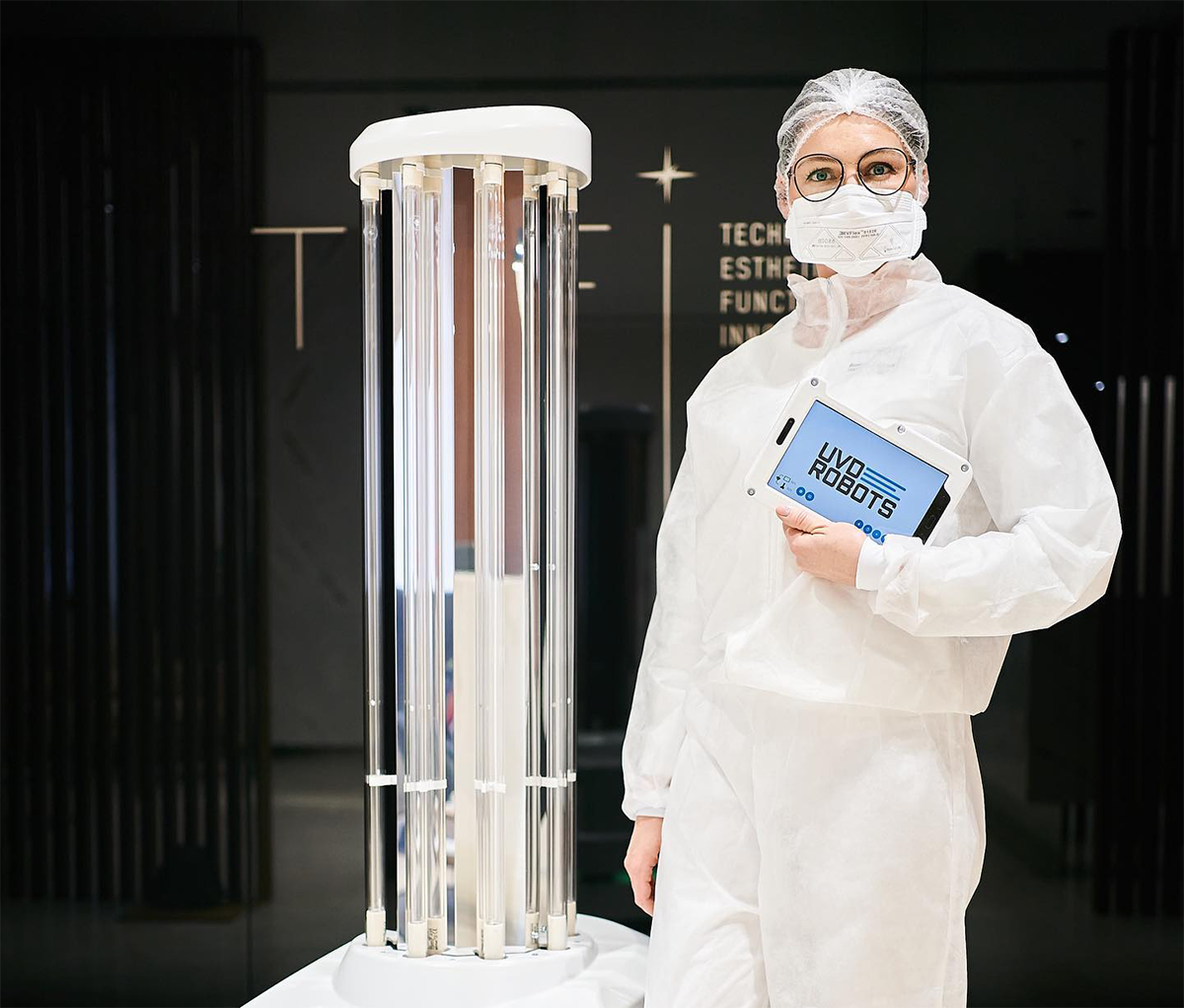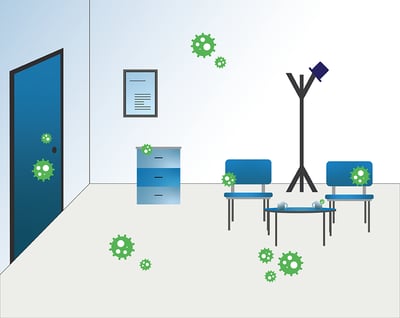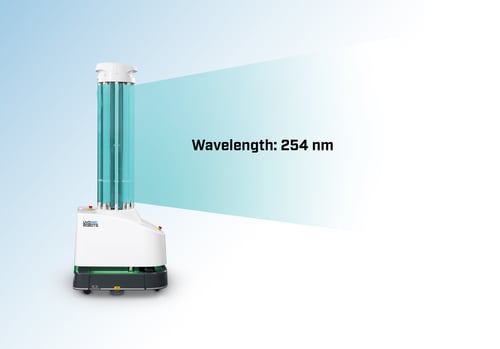Title
Content
Title
Content

Surface-level conditions play an important role in environmental hygiene quality in indoor environments. Though this is the case, how microorganisms persist on surfaces is not entirely understood. Here is a closer look at what we do know.
Environmental disinfection practices can involve a number of different areas in indoor spaces. Furniture, walls, and floors are all potential areas for environmental contamination. 
On these inanimate surfaces, various microorganisms can persist for different durations.1 Depending on the species, environmental conditions, and the type of surface involved, different microorganisms can survive for hours, days, weeks, or months at a time.2 3
How long a microorganism may last on a surface environment depends on a few factors, the first being the species of microorganism involved.4
The second factor may be the surface itself. A surface may be wet or dry, or be made of a substance that contributes to, or reduces, survival time.5 Surface compositions may also play a role.
There have been laboratory studies, for example, that have shown higher survival rates on cardboard surfaces over plastic surfaces. Lab studies have shown a difference in survival rates over time on stainless steel , depending on environmental conditions.6 Still other studies show decreased survival rates over time on wood surfaces.7 Overall, survival durations differ when different surfaces are involved.8
The final factor in a microorganism’s surface survival duration is its environment. In some bacteria species, for example, lab growth has been associated with variations in temperature and pH levels.9 Longer survival times in some species of bacteria have also been associated with surface environments with high relative humidities.10
Different species of microorganisms appear, at least in laboratory conditions, to have different surface survival durations. For example, survival durations of some different microorganisms on glass surfaces include:
These survival rates may differ depending on surface conditions. What is certain, however, is that there are disinfection solutions that address such microorganisms.
UVD Robots are an environmental disinfection solution that addresses different forms of microorganisms, especially microorganisms that occur on surfaces in indoor areas.
As a disinfection solution that utilizes Ultraviolet light, or UV light, UVD Robots can operate autonomously with minimal human contact. These are self-driving robots, which have been shown to reduce microorganisms at very high rates of efficacy.
UVD Robots use lamps that emit UV light at wavelengths of 254 nm – a wavelength associated in laboratory tests with over 3-log reductions of Staphylococcus aureus, Acinetobacter baumanni, and Klebsiella pneumoniae, representing a reduction rate of over 99.9%.13 14

Surface-level microorganisms are able to survive for different durations depending on their species, the surface composition, and other environmental factors.
UVD Robots, part of the Danish company Blue Ocean Robotics, are an autonomous robotic solution for surface-level environmental disinfection. They utilize UV light at wavelengths of 254 nm, wavelengths associated with high log reductions of different microorganisms.
With automated UV light disinfection solutions such as UVD Robots, surface-level microorganisms can be reduced at high rates of efficacy – providing cleaner environments for indoor areas.
1. Coughenour, Courtney et al. “An evaluation of methicillin-resistant Staphylococcus aureus survival on five environmental surfaces.” Microbial drug resistance (Larchmont, N.Y.) vol. 17,3 (2011): 457-61. doi:10.1089/mdr.2011.0007
2. Wilks, S A et al. “The survival of Escherichia coli O157 on a range of metal surfaces.” International journal of food microbiology vol. 105,3 (2005): 445-54. doi:10.1016/j.ijfoodmicro.2005.04.021
3. Katzenberger, Ruth Hanna, Anja Rösel, and Ralf-Peter Vonberg. "Bacterial survival on inanimate surfaces: A field study." BMC Research Notes 14 (2021): 1-10.
4. Katzenberger, Ruth Hanna, Anja Rösel, and Ralf-Peter Vonberg. "Bacterial survival on inanimate surfaces: A field study." BMC Research Notes 14 (2021): 1-10.
5. Grinberg, Maor et al. “Bacterial survival in microscopic surface wetness.” eLife vol. 8 e48508. 15 Oct. 2019, doi:10.7554/eLife.48508
6. Fuster-Valls, Nuria, et al. "Effect of different environmental conditions on the bacteria survival on stainless steel surfaces." Food control 19.3 (2008): 308-314.
7. Chen, Ju-Chi et al. “Survival of Bacterial Strains on Wood (Quercus petraea) Compared to Polycarbonate, Aluminum and Stainless Steel.” Antibiotics (Basel, Switzerland) vol. 9,11 804. 13 Nov. 2020, doi:10.3390/antibiotics9110804
8. Chen, Ju-Chi et al. “Survival of Bacterial Strains on Wood (Quercus petraea) Compared to Polycarbonate, Aluminum and Stainless Steel.” Antibiotics (Basel, Switzerland) vol. 9,11 804. 13 Nov. 2020, doi:10.3390/antibiotics9110804
9. Van den Berghe, Erika, Tom De Winter, and Luc De Vuyst. "Enterocin A production by Enterococcus faecium FAIR-E 406 is characterised by a temperature-and pH-dependent switch-off mechanism when growth is limited due to nutrient depletion." International journal of food microbiology 107.2 (2006): 159-170.
10. McEldowney, Sharron, and M. Fletcher. "The effect of temperature and relative humidity on the survival of bacteria attached to dry solid surfaces." Letters in Applied Microbiology 7.4 (1988): 83-86.
11. Katzenberger, Ruth Hanna, Anja Rösel, and Ralf-Peter Vonberg. "Bacterial survival on inanimate surfaces: A field study." BMC Research Notes 14 (2021): 1-10.
12. Andersen, Helle Stendahl. Analysis Report: Test of UV Disinfection Robot acc. NF T72-281. Report Number 754372_Rev. 2. Danish Technological Institute, 2020.
13. Edwards-Jones, Val. "Assessment of UVD Robot Against Reduction of MultiDrug Resistant Klebsiella pneumoniae, Acinetobacter baumannii and Clostridium difficile on Surfaces." Essential Microbiology Ltd. and Melbec Microbiology Ltd., Apr. 2019, www.melbecmicrobiology.co.uk, www.essentialmicrobiology.com.
Lorem ipsum dolor sit amet, consectetur adipiscing elit, sed do eiusmod tempor incididunt ut labore et dolore magna aliqua.